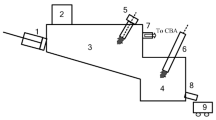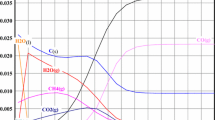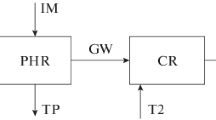Abstract
This paper presents the results of computational and experimental studies of the electroplasma gasification of carbon-containing technogenic wastes to obtain high-calorific-value syngas (H2 + CO) for power-generating devices. The composition of the syngas produced by gasification of organic wastes was experimentally determined. The change in the composition and calorific value of the syngas depending on the gasification time of organic materials was studied. The change in the calorific value of the syngas during waste gasification is considered.
Similar content being viewed by others
INTRODUCTION
Humanity is currently facing a number of environmental challenges, among which the decontamination and disposal of technogenic formations and waste occupies an important place. The amount of wastes is increasing year by year as the economic, social, and environmental conditions of human life change. One type of technogenic waste is biomedical waste and materials. Their disposal has become especially important due to the COVID-19 pandemic, which has led to a significant increase in the number of disposable medical masks and clothing. According to the Russian legislation, all medical wastes are subject to mandatory environmentally-safe disposal.
Thermal methods, including the incineration of medical waste and materials, do not lead to the complete decomposition of complex chemical compounds into simple substances since the temperature level in such technologies does not exceed 800–850°C . Electroplasma technology is optimal in terms of safety, performance, and efficiency, but its application is currently limited by high operating costs. Reducing these costs would make it possible to use plasma installations for recycling, gasification or disposal of wastes of various morphological compositions.
A distinctive feature of plasma gasification is that the gasifier includes an electric-arc plasma generator—a plasma torch capable of heating gas to several thousand degrees. An increase in the mass-average temperature in the reaction zone of the gasifier within 1200–1400°C creates conditions for the decomposition of harmful chemical compounds. For example, the decomposition of dioxins requires a temperature of \(\approx\)1300°C for 2 s. Obtaining molten inert slag from the inorganic part of the waste (ash and slag formations) requires temperatures of 1300–1600°C or higher [1].
The use of plasma technology for processing, decontaminations, and disposal of hazardous medical materials requires integrated tests of an energy-efficient and environmentally friendly electroplasma installation on a test stand to determine the best technological parameters: the composition of exhaust gases, their dependence on the temperature in the plasma electric furnace chamber, calorific-value of syngas, etc.
EXPERIMENTAL STUDIES
When solving the problem of gasification (utilization or disposal) of wastes, it is necessary to bear in mind that this is a set of environmental and energy problems associated with the use of these wastes as a renewable energy source. Figure 1 shows calculated calorific values of household waste, brown coals, and other fuels versus their carbon and hydrogen contents [2].
The energy characteristics of wastes are calculated using the material composition, i.e., the main chemical elements included in organic wastes in locally averaged form: carbon, hydrogen, oxygen, nitrogen, sulfur, water (moisture), and ash.
Calorific value of various types of fuel versus the mass fractions of carbon and hydrogen: points BC1–BC3 refer to the coals of the Kansk–Achinsk basin, points BC4–BC6 to the Dnieper basin, points SOW7–SOW12 to the solid organic waste from Canada, USA, Netherlands, Moscow, Madrid, and Yekaterinburg, respectively, and point MBC refers to brown coal near Moscow, MP to milled peat, F to firewood, and OSh to oil shale.
Any other solid organic fuel has exactly the same set of elements. It can be seen from Fig. 1 that the calorific values of brown coals (BC) and solid organic wastes (SOW) depend linearly on the mass fractions of carbon and hydrogen; moreover, SOW7–SOW10 turn out to be better in terms of calorific value than BC5 (Morozovskii mine) and BC6 (Golovkovskii mine) brown coals.
The studies were carried out on an experimental plasma-arc installation with a capacity of 20 kg/h for municipal solid waste of average composition. A sketch of the installation is shown schematically in Fig. 2. The water-cooled body of the installation is made of sheet steel, and the inner wall of the body is made of refractory and thermal insulation materials. The inner chamber of the plasma-arc electric furnace has two interconnected chambers: a melting chamber with a volume of 0.074 m3 with a 50 kW plasma torch and a gasification chamber with a volume of 0.11 m3.
The temperature in the gasification chamber of the furnace is 1300–1500°C . This temperature level is achieved by using an electric-arc plasma torch with a power of 20–50 kW.
Portions of packaged material to be processed are fed into the gasification chamber through a loading device. The loading device also serves as a lock chamber, preventing the entry of atmospheric air into the gasification chamber and the exit of flue gases from the chamber into the atmosphere when excess pressure occurs during waste processing. The working chamber of the plasma electric furnace and the lining are heated by the electric-arc plasma torch. The mass average temperature of the air plasma flowing from the plasma torch is 4000 K. The combustible syngas released in the gasification zone is fed into a purification unit (centrifugal bubbling apparatus) to harden the composition and clean it from dust, and simultaneously it is fed into a Test-1 gas analyzer, which determines the volume content of gas components in real time.
The temperature \(T\) and gas composition \(G\) were determined along the entire gas path (see Fig. 2). The ash residue formed after waste gasification and containing underburnt particles and carbon residue is exposed to a plasma jet, where carbon afterburning and remelting of the ash residue into inert slag occur. As the bath is filled, the molten liquid slag is periodically poured through the taphole into a rolling cart. In addition to the above equipment, the installation includes a power source and a control panel of the plasma torch, a gas and water supply system, a gas analyzer, a supply and exhaust ventilation system, a waste supply control panel, an afterburner, and a flue gas cooler.
Fuel gas is supplied from the centrifugal bubbling apparatus to the afterburner chamber (\(T \approx 1200\)°C ), where it is oxidized to CO2. Before being released into the atmosphere, the gas passes through a mixer, where it is cooled by mixing with the required amount of atmospheric air.
Before the experiment, the furnace chamber and lining were heated to the operating temperature. The plasma torch was used to achieve and maintain the operating temperature throughout the chamber of the electric furnace. Once the working temperature was reached, packaged medical materials (medical masks) were loaded in portions at into the furnace chamber at certain time intervals.
RESULTS OF EXPERIMENTS
Analysis of the elemental composition of organics, including biomedical waste, namely medical masks and disposable syringes, showed that medical masks were
made of polymers with a wide molecular weight distribution, such as polypropylene, and disposable medical syringes were made of polyvinyl chloride. The elemental composition of the wastes is given in Table 1.
The gasification of carbon-containing (organic) materials can be described in simplified form by the basic chemical reactions given in Table 2. In the steady-state operation of the electric furnace, stationary vertical distributions of temperatures of the moving wastes and gas flow are established. The reaction proceeds in the presence of reagents in the reaction space at a temperature above the equilibrium value. During sequential heating, the wastes undergo decomposition with the release of various gaseous substances, which are then involved in oxidation reactions (see Table 2).
Figure 3 shows the experimental results of gasification of medical masks. It can be seen that during the gasification of the bulk of materials, the calorific value of the gas reaches a peak and then gradually decreases. The occurrence of the peak is due to the fact that in the experiments, the wastes were fed in portions into the gasification chamber of the plasma electric furnace at certain time intervals. The waste supply should be continuous to provide a constant calorific value of the flow.
Figure 4 shows the results of measuring the composition of gasification products of organic wastes in the same period of time as in Fig. 3. A comparison of these two figures indicates that maximum thermal efficiency is reached when the syngas contains 26% CO, 22% CH4, and 13% N2 has the. In this case, its calorific value is 10–12 MJ/nm3.
The experiment was carried out at a temperature of 1300°C in the reaction zone of the electric furnace. According to experimental data, the gas contains no nitrogen oxides and dioxide and also contains little carbon dioxide. The peaks in the graph in Fig. 4 are explained by the discrete supply of packaged wastes. To achieve a uniform release of syngas during gasification, it is necessary to produce a uniform loading of wastes into the chamber of the plasma electric furnace.
CONCLUSIONS
Preliminary analysis of the thermodynamic reactions [1] and chemical composition of disposed wastes (medical materials—disposable masks) showed the possibility of plasma gasification. The electroplasma installation taken as a basis and the technological process of plasma gasification of organic wastes are suitable for environmentally-safe disposal of medical materials. Analysis of experimental data leads to the conclusion on the application of the developed installation for gasification of organic wastes with the formation of a high-calorific-value gas. The setup was tested for disposal of biomedical materials.
This work was supported by the Ministry of Science and Higher Education of the Russian Federation (State registration No. 121031800229-1).
REFERENCES
V. A. Faleev, E. B. Butakov, and S. I. Rad’ko, “Thermodynamic Analysis of Gasification of Renewable Carbonaceous Materials of Natural and Artificial Origin in Plasma Electric Furnace," Teplofiz. Aeromekh. 24 (4), 633–638 (2017) [Thermophys. Aeromech.я 24,я615–620 (2017); https://doi.org/10.1134/S0869864317040138].
V. S. Cherednichenko, A. S. An’shakov, and M. G. Kuz’min, Plasma Electrotechnological Installations (Novosibirsk State Tech. Univ., Novosibirsk, 2011) [in Russian].
A. S. An’shakov, V. A. Faleev, A. A. Danilenko, E. K. Urbakh, and A. E. Urbakh, “Investigation of Plasma Gasification of Carbonaceous Technogeneous Wastes," Teplofiz. Aeromekh. 14 (4), 639–650 (2007) [Thermophys. Aeromech.я 14,я607–616 (2007); https://doi.org/10.1134/S0869864307040105].
P. V. Domarov, “Electrotechnology for Processing Industrial Waste in a Plasma Furnace with Improved Energy Characteristics," Candidate’s Dissertation in Tech. Sci. (Novosibirsk State Tech. Univ., Novosibirsk, 2013).
Author information
Authors and Affiliations
Corresponding authors
Additional information
Translated from Fizika Goreniya i Vzryva, 2022, Vol. 58, No. 4, pp. 107-111.https://doi.org/10.15372/FGV20220412.
Rights and permissions
About this article
Cite this article
An’shakov, A.S., Domarov, P.V. & Butakov, E.B. Plasma-Thermal Gasification of Organic Wastes. Combust Explos Shock Waves 58, 490–493 (2022). https://doi.org/10.1134/S0010508222040128
Received:
Revised:
Accepted:
Published:
Issue Date:
DOI: https://doi.org/10.1134/S0010508222040128








